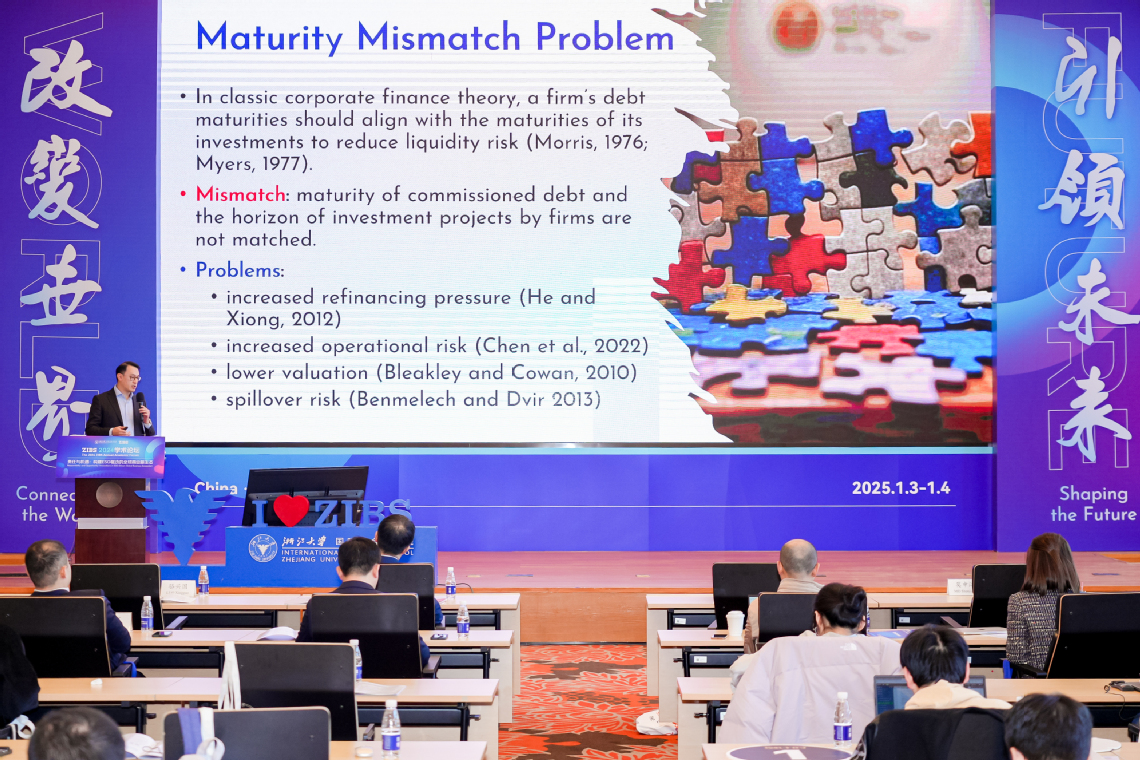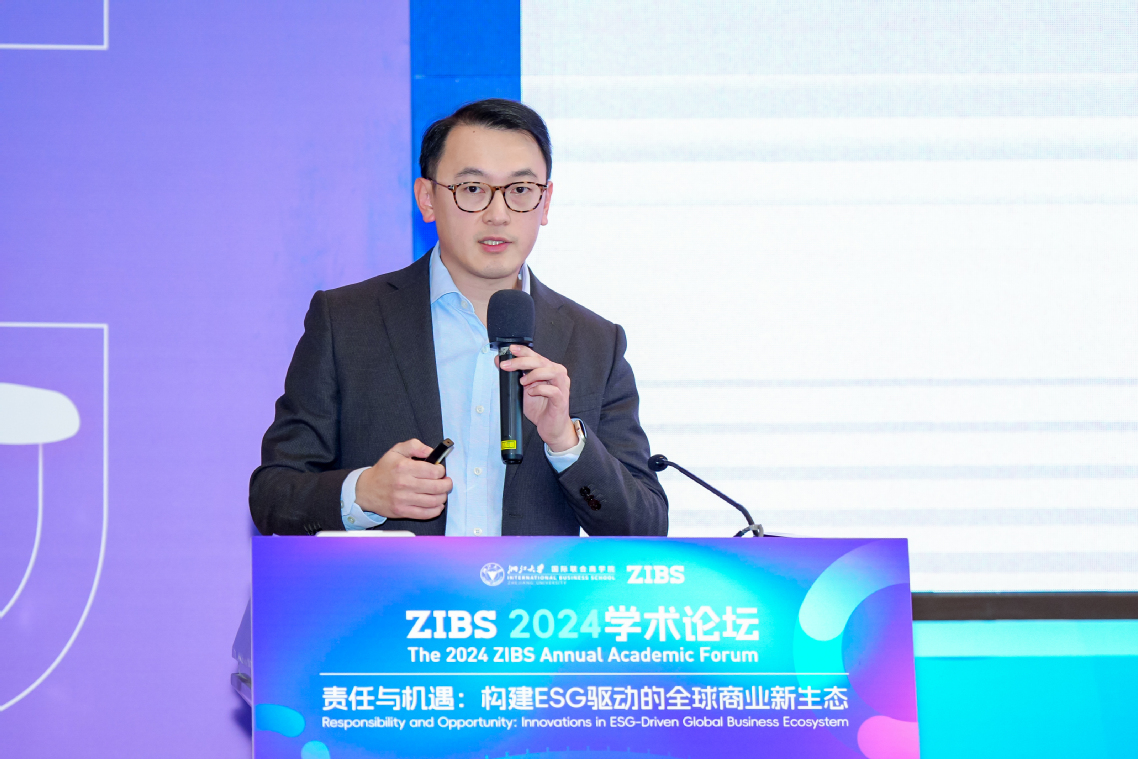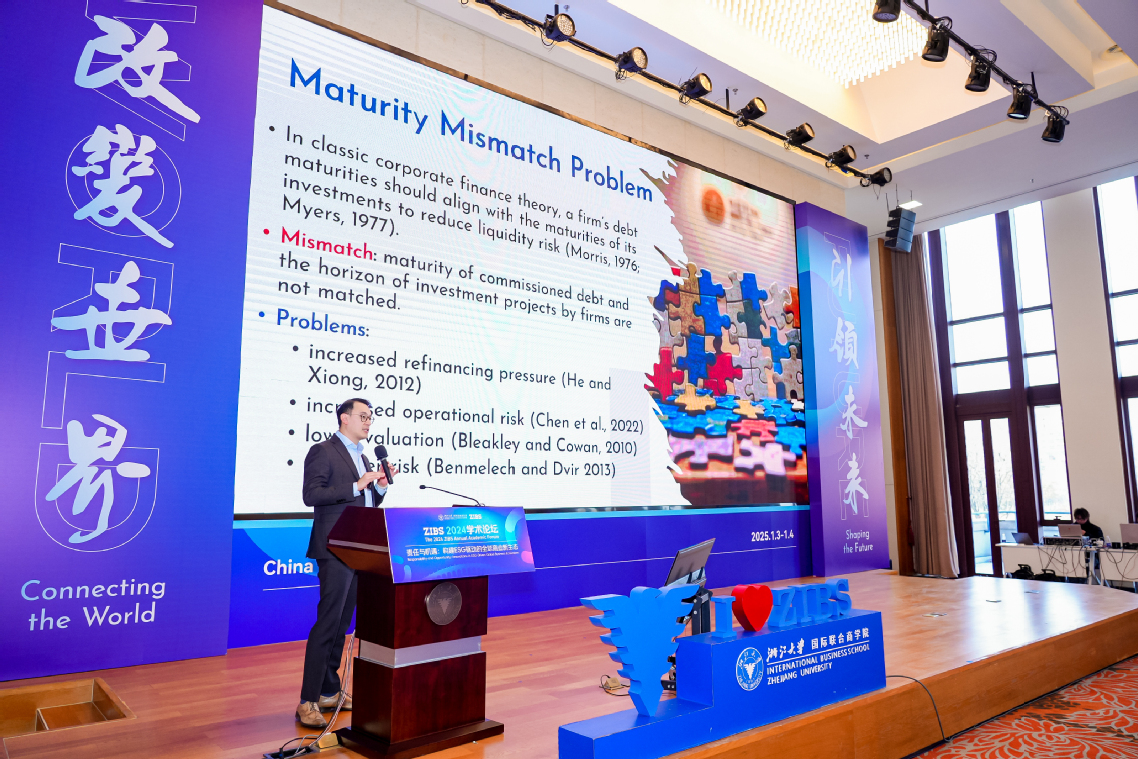At the beginning of January, the 2024 ZIBS Annual Academic Forum, themed Responsibility and Opportunity: Building an ESG-Driven Global Business Ecosystem, was successfully held in the International Campus. The forum delved into cutting-edge topics such as data intelligence, environmental science, fintech, digital innovation, and corporate renewal. It aimed to share the latest research findings, innovative ideas, and practical experiences, offering profound insights and strategies for the sustainable development of global business, technology, and education.
This issue of the ZIBS Insights spotlights the keynote speech delivered by Raymond So, ZIBS Associate Professor. He presented his innovative research on the topic of the role of policy and the interest rate transmission channel. Below is a summary of the key points.
Introduction to the Maturity Mismatch Puzzle
The presentation began with a discussion of the maturity mismatch puzzle within the context of classical corporate finance theory. Maturity mismatch occurred when a company's debt maturity profile didn't align with the maturity of its underlying projects, potentially leading to financial and operational risks. Companies were often faced with the challenge of financing long - term investments with short - term debts. This mismatch could result in increased refinancing pressure, operational risk, and a lower overall valuation of the company due to the higher perceived risk by investors and lenders. Raymond So explained how such a mismatch could negatively impact a company's equity value, especially when not properly managed, and discussed how firms might face difficulties in securing long - term financing, thereby exacerbating the mismatch.
Supply-Side and Demand-Side Theories
To understand the root causes of maturity mismatch, Raymond So discussed two key theories—supply - side theory and demand - side theory.
Supply-side theory: This theory focuses on the limitations from the lenders' side. It suggests that banks or other financial institutions may be hesitant to provide long-term loans due to information asymmetry—where banks have limited access to detailed, long-term financial information about the borrowing companies. Lenders are also concerned about the challenges in assessing long-term risks, which may prevent them from offering long-term credit at favorable terms.
Demand-side theory: This theory centers on the preferences of firms. According to this theory, companies may intentionally seek short-term debt to reduce immediate costs, as short-term interest rates are often lower compared to long-term rates. Additionally, short-term debt offers more flexibility to the company, allowing it to adapt to changing market conditions or business needs without being locked into long-term obligations.
Raymond So emphasized that understanding whether the maturity mismatch was driven by the supply side or the demand side was crucial for designing appropriate policies and solutions. Addressing this issue was essential for promoting more sustainable corporate finance practices, especially as firms aimed to balance risk with long - term investments.

Policy Intervention: A Natural Experiment in China
To address the maturity mismatch issue, Raymond So discussed an innovative policy experiment implemented in China starting in 2016. This experiment involved a pilot program aimed at improving the maturity structure of debt by offering favorable terms to companies within certain sectors, thus potentially mitigating the maturity mismatch problem.
The program was designed to improve information exchange, governance, and financial innovation, targeting improvements in the way financial institutions assessed risk and made lending decisions. The policy was expanded over time to include various regions, and the program incentivized firms to take part in long - term projects with better financing conditions, particularly focusing on companies that were previously constrained by the short - term nature of their debt.
Impact of the Policy on Maturity Mismatch
The analysis of the policy's effects showed that it had a notable impact on reducing maturity mismatch in the treated sample of firms. The policy facilitated a shift toward longer - term debt arrangements, providing evidence that the supply - side constraints were a key factor contributing to the maturity mismatch. By providing more transparent information and better lending conditions, the policy helped banks feel more confident about offering long - term loans to firms, which led to a reduction in short - term debt reliance.
The findings suggested that, as a result of the policy, the maturity mismatch for firms in the treated group decreased by up to 15%. This was significant because it meant that firms could better align the maturity of their debts with the lifespans of their projects, reducing the risks associated with refinancing and helping ensure more stable long - term financing. The reduced reliance on short - term debt helped to lower the operational and financial stress that companies faced when refinancing large sums on short timelines.

Mechanisms Behind the Policy's Effectiveness
Three key mechanisms were identified as contributing to the success of the policy:
1 Improved Information Exchange: The policy encouraged better communication between lenders and borrowers. Through the pilot program, firms were able to provide more detailed and reliable information about their financial health and the risks associated with long-term projects. This transparency helped lenders feel more comfortable providing long-term loans to firms, reducing the hesitancy caused by information asymmetry.
2 Monitoring Mechanism: Firms participating in the program were required to submit regular updates about their financial activities and the use of borrowed funds. This monitoring system helped ensure that the borrowed funds were being used efficiently and for their intended purposes, which helped reduce the risk associated with long-term loans.
3 Improved Lending Conditions: The program also made it more attractive for firms to borrow long-term by improving the terms of these loans. The government's policy-driven incentives allowed banks to offer longer-term loans at more favorable conditions, thus making these options more appealing for firms compared to short-term loans.
These mechanisms contributed to the shift in firms' financing behavior, from relying on short-term debt to utilizing more long-term financing, thus reducing the maturity mismatch and the associated risks.
Findings and Policy Implications
The analysis and findings from this study had several important implications for policy and business practice. The policy was successful in reducing maturity mismatch, and it offered valuable insights into the role that improved information exchange, governance, and financial innovation could play in addressing the supply - side constraints that contributed to maturity mismatch.
The results underscored the importance of regulatory intervention in creating favorable conditions for long - term financing, particularly in contexts where information asymmetry and risk assessment challenges were present. This was especially relevant for firms in industries that faced significant financing barriers. The study also highlighted the importance of regulatory support in easing financial stress for firms. By creating conditions where long - term debt was more accessible and attractive, policymakers could help ensure that companies were better positioned to invest in long - term projects without the risk of short - term refinancing pressure.
*This article is based on the speech made by Raymond So at 2024 ZIBS Academic Forum. The views and opinions expressed in this article are those of the speaker and do not necessarily reflect the views or positions of ZIBS.
Raymond So is an Associate Professor at ZIBS. Prior to joining ZIBS, he worked at King's College London as an Assistant Professor of Finance. His research primarily focuses on empirical asset pricing, behavioral finance, and financial technology. He has published in the Review of Finance, Journal of Corporate Finance, European Journal of Operational Research, among others.




